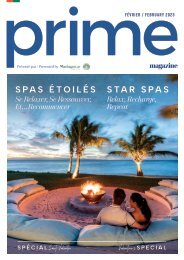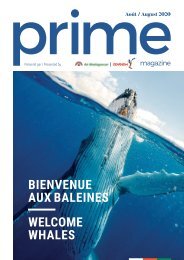Prime Magazine June 2023
Prime Magazine Madagascar June 2023 Edition
Prime Magazine Madagascar June 2023 Edition
Create successful ePaper yourself
Turn your PDF publications into a flip-book with our unique Google optimized e-Paper software.
DESTINATIONS<br />
Sainte-Luce<br />
BEAUTE PURE<br />
À plus de 40km au nord de Taolagnaro, Sainte-Luce, connue<br />
pour sa biodiversité exceptionnelle, offre un paysage<br />
sauvage de pure beauté typique de la Région Anosy.<br />
PURE BEAUTY<br />
More than 40km to the north of Taolagnaro, Sainte-Luce, wellknown<br />
for its exceptional biodiversity, presents an unspoilt<br />
landscape of pure beauty typical of the region of Anosy.<br />
Sainte-Luce est d’abord un site historique. Autrefois<br />
comptoir commercial français sous l’administration du<br />
colon Jacques Pronis, elle fut aussi et auparavant, une<br />
terre d’escale des commerçants sur la Route de l’Inde.<br />
Seuls quelques vestiges en pierre subsistent aujourd’hui<br />
et témoignent de cette époque. Aujourd’hui Sainte-Luce<br />
est un village de pêcheurs, dont le marché aux poissons<br />
rythme la vie quotidienne.<br />
Mais Sainte-Luce, ou Magnafiafy de son nom<br />
malgache, est également un site touristique très<br />
convoité pour sa biodiversité. Située en zone humide,<br />
sa faune et sa flore sont prolixes. Le site possède une<br />
réserve naturelle et des dernières forêts tropicales<br />
intactes de la Grande Île. On y trouve plusieurs espèces<br />
de lémuriens, dont le lémurien à collier rouge et le<br />
microcèbe roux. La réserve possède 70 espèces<br />
d’amphibiens et de reptiles.<br />
Les amateurs de plongée pourront découvrir ses récifs<br />
coralliens et admirer une grande variété de poissons<br />
ainsi que des tortues de mer.<br />
Dans les mangroves vivent des crocodiles du Nil, en<br />
mer des dauphins et de juin à novembre, il est possible<br />
d’observer les baleines à bosse nager le long de la côte.<br />
Sainte-Luce is first of all a historical site. It was a<br />
former French trading post under the administration<br />
of the settler Jacques Pronis, before that it had been<br />
a port of call for traders sailing to and from India.<br />
Only a few stone vestiges bearing witness to the<br />
period remain today. Sainte-Luce is now a village of<br />
fishermen, with their lives revolving around the fish<br />
market.<br />
But Sainte-Luce, or Magnafiafy in Malagasy, is<br />
also a very popular tourist destination, sought-after<br />
for its biodiversity. Lying in the tropical zone, it has<br />
abundant fauna and flora. The site has a nature<br />
reserve with Madagascar’s last remaining untouched<br />
tropical forests, sheltering several species of lemur,<br />
including the red-collared lemur and the red mouse<br />
lemur. The reserve has 70 species of amphibians and<br />
reptiles.<br />
Those who love diving can discover the coral reefs<br />
with a huge variety of fish, as well as sea turtles.<br />
In the mangroves, there are Nile crocodiles, in the<br />
sea dolphins and from <strong>June</strong> to November, there is<br />
potential to view humpback whales swimming past<br />
the coast.<br />
© : ORT ANOSY<br />
online at www.primemedia.international / 115
















